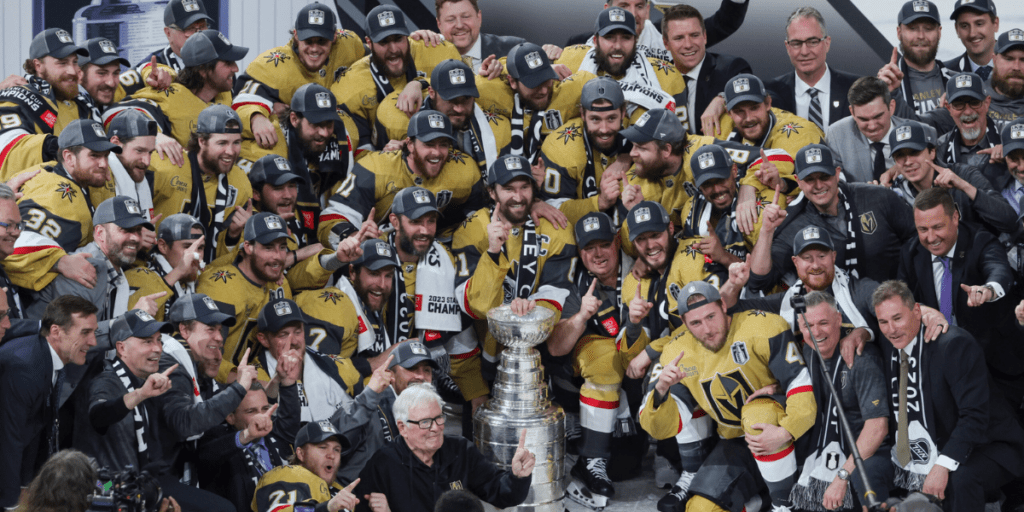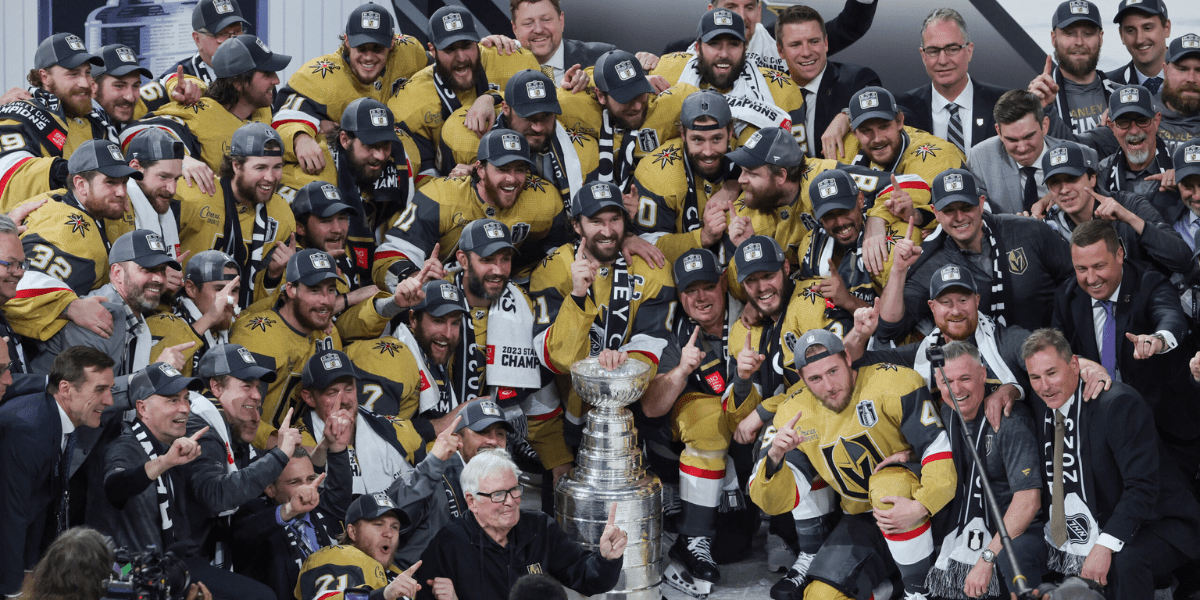
A Brief Overview of the Vegas Golden Knights
The Vegas Golden Knights are among the NHL’s most exciting teams. In just a few short years, they’ve gone from an expansion team to a Stanley Cup contender, making it to the finals in their first year. They’ve consistently been one of the top teams in the league, with a roster full of talented players who have helped them succeed on the ice.
The Importance of the NHL Salary Cap
The NHL salary cap is critical for all teams in the league. It ensures that no team can buy all the best players and dominate year after year. Instead, each team has a set amount they can spend on player salaries each season, forcing them to be strategic about which players they sign and how much they pay them.
The salary cap has helped create parity across all teams in the league and has made for some truly exciting competition over recent years. Teams must be smart about managing their finances to stay competitive over time.
What Sets Vegas Apart
Despite being bound by these strict financial limits, The Golden Knights have found ways to succeed where other teams have struggled. They’ve managed their finances well while building a talented roster to compete with anyone in the league.
This comes down largely to smart management by GM Kelly McCrimmon and his team. They’ve made savvy moves with trades and free-agent signings while developing young talent through draft picks.
Ultimately, success in today’s NHL requires more than just money – it also requires good management and careful planning. And that’s something that The Golden Knights have truly excelled at since joining this great league.
Looking Ahead
As we look ahead to the upcoming season, we can’t wait to see what The Golden Knights have in store. They’ve built a strong foundation, and with a few key additions and some smart drafting, they could be poised for another run at the Stanley Cup.
Of course, that all depends on how well they can manage their finances under the salary cap. But given their track record so far, we’re confident that they’ll continue to find ways to build a winning team without breaking the bank.
The Basics of the Salary Cap
Definition of the salary cap and how it is calculated
The NHL salary cap limits the amount of money a team can spend on player contracts in any season. The 2020-2021 season’s salary cap was $81.5 million USD.
The idea behind this system is to ensure that teams can compete on a level playing field, regardless of their market size or financial resources. The salary cap calculation is based on league revenue projections for the upcoming season.
The NHL Players’ Association (NHLPA) and the league negotiate to determine what percentage of league revenue will be allocated toward player salaries. This percentage then determines the overall salary cap figure.
Explanation of how teams can exceed the cap through various exceptions
While there are strict rules surrounding salary caps, several exceptions also allow teams to exceed them under certain circumstances. These include: – Performance bonuses: Performance bonuses can be added to contracts for players who meet certain benchmarks throughout the season.
These bonuses do not count against the team’s salary cap, and teams can use them to incentivize and reward players without sacrificing their overall budget. – Injured reserve: If a player is placed on injured reserve (IR), their contract no longer counts against their team’s salary cap until they are healthy enough to return to play.
– Long-term injured reserve: In some cases, if a player is expected to miss a significant amount of time due to injury, they can be placed on long-term injured reserve (LTIR). This allows their team to exceed the salary cap by an amount equal to or less than their contract value until they return.
– Buyouts: Teams may buyout player contracts to free up space under their salary cap. However, this often comes with significant costs and can negatively impact a team’s long-term financial situation.
While these exceptions can be useful tools for teams looking to manage their salary cap situations, they also come with risks and drawbacks. For example, relying too heavily on performance bonuses can lead to issues if players do not meet their benchmarks while buying out contracts can have significant financial implications in the future.
The NHL salary cap is a complex system requiring teams’ careful management and strategic decision-making to remain competitive. While exceptions can help teams navigate this system, ensuring that these decisions are made with long-term goals is important.
The Golden Knights’ Salary Cap Situation
Overview of the Golden Knights’ current salary cap situation
The Vegas Golden Knights have been a force to be reckoned with since their inaugural season in 2017-2018, making it to the Stanley Cup Final in their first year and consistently competing as one of the top teams in the league. However, maintaining that success comes at a cost, and the team’s salary cap situation is no exception.
CapFriendly reports that the Golden Knights have roughly $6 million in available cap space for the 2021-2022 season. While that may seem like a decent amount, it’s important to note that they also have several key players who are due for contract extensions soon.
Discussion of key players on their roster and their impact on the team’s finances
One major factor impacting the Golden Knights’ salary cap is their top-heavy roster. The team has several high-profile players who take up a significant chunk of their cap space, including Max Pacioretty ($7 million AAV), Mark Stone ($9.5 million AAV), and Alex Pietrangelo ($8.8 million AAV). While these players are undoubtedly talented and contribute greatly to the team’s success, their hefty salaries leave little room for other signings or extensions.
It’s been reported that negotiations with defenseman Alec Martinez have stalled due to cap constraints. Another player whose contract situation will be interesting to watch is goalie Robin Lehner.
He signed a five-year deal worth $25 million last offseason but has struggled with injuries and inconsistent play this season. If he doesn’t improve soon, his contract could become an albatross for the team.
Overall, while it’s clear that the Golden Knights have assembled an impressive roster filled with talented players, managing their finances will be key to maintaining their success. They must make shrewd decisions regarding contract extensions and free-agent signings to avoid getting stuck in cap hell.
Creative Section: The High Rollers
Are the Golden Knights’ Highest-Paid Players Worth Their Hefty Salaries?
Regarding the Vegas Golden Knights, a few players stand out as the highest-paid on the roster. These high rollers include stars like Mark Stone, Max Pacioretty, and Jonathan Marchessault. While these players are undoubtedly talented, the question remains: are they worth their hefty salaries?
Let’s start with Mark Stone, who signed an eight-year contract worth $76 million in 2019. Stone is a dynamic player who brings a lot of skill to the ice.
He’s known for his strong defensive play and ability to create scoring opportunities for his teammates. While he’s certainly a valuable asset to the team, his $9.5 million salary cap hit is one of the highest in the league.
Next is Max Pacioretty, acquired by Vegas through a trade with Montreal in 2018. Pacioretty signed a four-year contract extension worth $28 million shortly after joining the team.
His salary cap hit of $7 million makes him one of the highest-paid players on the Golden Knights roster. Pacioretty is another talented player who brings scoring ability and leadership to the team.
There’s Jonathan Marchessault, who signed a six-year contract extension worth $30 million in 2018. Marchessault is known for his offensive prowess and has contributed to Vegas’ success since joining the team in their inaugural season in 2017-18.
However, his $5 million salary cap hit may seem steep for some fans. So, are these high rollers worth their hefty salaries?
In my opinion, it depends on how you define “worth.” From a pure talent perspective, all three players bring much value to the ice and have helped Vegas become a competitive team in the league. However, financially, their salaries may hinder the team’s ability to make other moves and improve in areas of weakness.
Impact on the Golden Knights’ Finances
While Stone, Pacioretty, and Marchessault are all talented players, their hefty salaries significantly impact the Golden Knights’ finances. With a salary cap of $81.5 million for the 2020-21 season, these three players alone account for over $21 million. That’s nearly 26% of the team’s entire salary cap space!
This means Vegas has less money when signing other players or making trades. While Stone and Pacioretty are important contributors to the team’s success, it’s worth considering whether or not their salaries are inhibiting the Golden Knights from addressing areas of weakness on their roster.
Additionally, all three players are signed to long-term contracts that could become burdensome in future seasons. As they age or if their production declines, these contracts could become difficult for Vegas to manage within the constraints of the salary cap.
Their Contributions to The Ice
When analyzing whether or not these high rollers are worth their salaries solely based on their contributions on the ice, there is no doubt that each player brings something unique and valuable to this team. Mark Stone is an efficient scorer and one of the NHL’s best defensive forwards known for his great stickwork and hockey IQ regarding turnovers. Max Pacioretty has been one of if not THE most consistent scorers since coming into this league, with his laser shot finding its way into opposing nets more often than not; he’s also an above-average two-way player known for his speed and skating ability.
Jonathan Marchessault is known as one of the league’s best wingers for his slick hands and quick release. He has contributed to the Golden Knights’ success since day one with their expansion draft in 2017-18.
All three players bring unique skills to the team, and their contributions on the ice cannot be ignored. However, given their salaries, it’s worth considering whether or not there are other areas of need on the roster that could be addressed with that money.
The Golden Knights’ Future
It will be interesting to see how these high rollers continue to perform and how their salaries impact the Golden Knights’ ability to compete in future seasons. With long-term contracts in place, Vegas will need to carefully manage its finances to remain competitive while also addressing areas of weakness on its roster.
It’s possible that these high rollers will continue to contribute at a high level and justify their hefty salaries. Alternatively, if their production declines or they suffer injuries, Vegas may find itself in a difficult situation with limited financial flexibility.
While Stone, Pacioretty, and Marchessault are undoubtedly talented players who bring value to the Golden Knights roster, their hefty salaries impact the team’s finances and ability to move in other areas. It remains up for debate whether or not these players are ultimately worth their paychecks from a long-term financial perspective. Only time can tell, but they continue to be highly valued members of this successful NHL franchise.
The Golden Knights’ Balancing Act: Entry-Level Contracts
The NHL salary cap is tricky to manage, and entry-level contracts are just another layer of complexity to it. For those unaware, an entry-level contract is the first contract a player signs in the NHL after being drafted. These contracts have specific terms and conditions, including maximum salary and bonuses.
One of the greatest benefits of entry-level contracts is that they offer teams an opportunity to lock down young talent at a relatively low price point while having more control over their development. For example, Cody Glass, drafted sixth overall by the Golden Knights in 2017, signed his entry-level contract worth $925k annually for three years.
With Glass’s talent level and potential upside, that’s an absolute bargain for Vegas. On the other hand, there are some downsides to these contracts as well.
If a player performs exceptionally well during their entry-level contract period, they become restricted free agents with more bargaining power when it comes time to negotiate a new deal. And therein lies the conundrum: how do you balance developing your young talent while managing your salary cap effectively?
The Golden Knights have been no stranger to this challenge. They have some promising young players on their roster who came in on entry-level deals but will be due for hefty pay increases soon enough if they continue performing at high levels.
One such player is defenseman Zach Whitecloud who recently signed a two-year deal worth $1.45 million annually after playing out his two-year ELC. Managing these situations requires careful planning and foresight from management – something I’m not entirely convinced that Vegas has done as well as some might think.
Is Vegas Maximizing its Potential with Entry-Level Contracts?
In theory, entry-level contracts should be one of the most effective ways for an NHL team to build and maintain a talented roster while also controlling their salary cap situation. But is Vegas making the most of these contracts?
Of all the players on ELCs with the Golden Knights, only a handful have moved on to bigger and better deals. Shea Theodore, Alex Tuch, and William Karlsson are among those who received big pay raises after their entry-level contracts expired.
But what about the rest? For example, Nicolas Hague – who was selected 34th overall in 2017 – has played in just 31 games across two seasons for Vegas and remains on his ELC with a cap hit of $791k per year.
Given his limited NHL experience so far, that’s not an unreasonable amount to pay him. However, if he blossoms into an impact player in the coming years, he will likely demand a much higher salary.
I’m not saying that every single player who signs an entry-level contract needs to turn into a superstar for it to be worth it. I am saying that Vegas needs to do a better job identifying which players are most likely to develop into top-tier talent and invest more heavily in those guys from the get-go.
Conclusion
Managing an NHL team’s salary cap requires balancing talent development with financial constraints – something that’s easier said than done. Entry-level contracts offer one way for teams like Vegas to get ahead while staying within budget, but they require careful planning and foresight.
While there are certainly some successes regarding the Golden Knights’ use of entry-level contracts (Karlsson being one prime example), there are also some missed opportunities (like Hague). The team needs to do more work in this area to continue competing at a high level without becoming shackled by their payroll.
It’s not enough to sign promising young athletes; Vegas needs to keep a close eye on their development and be prepared to pay up when it comes time for them to sign new deals. Only then can they truly maximize their potential while staying on budget.
Rarely Known Small Details: Performance Bonuses
What are performance bonuses?
Performance bonuses are a tool that NHL teams can use to incentivize players to achieve certain milestones or exceed expectations. These bonuses are typically included in a player’s contract and can vary depending on the individual player’s role and skill level.
Some common examples of performance bonuses include point milestones, games played thresholds and playoff success. So how do these bonuses affect a team’s salary cap situation?
The answer is that the NHL has strict rules regarding how much teams can exceed the salary cap. Any performance bonuses earned by players count towards the team’s overall spending for that season, which means that if a team exceeds their allotted cap space due to these bonuses, they may be subject to penalties such as fines or loss of draft picks.
Golden Knights’ performance bonus situation
So what does this mean for the Golden Knights? Several key players on their roster have earned significant performance bonuses in recent years. In fact, during their inaugural season in 2017-2018, five players (including star forward William Karlsson) earned over $1 million in performance-based pay.
While these payouts may seem excessive at first glance, it’s important to remember that they are only given out if a player meets certain criteria – in other words, they have to earn them through their on-ice performance. Additionally, since these payments count towards the team’s total spending for that season, it’s not like they’re coming out of an entirely separate budget.
Are performance bonuses worth it?
Whether or not performance bonuses are worth it has been debated among fans and analysts alike for years. On the one hand, they can serve as a powerful motivator for players and help ensure everyone is working towards a common goal.
On the other hand, they can also be seen as a potential source of conflict between players and teams – if a player feels as though they are being unfairly compensated for their contributions, it could lead to tension in the locker room. Ultimately, whether or not performance bonuses are worth it comes down to a matter of strategy and team culture.
For the Golden Knights, it seems as though they have decided that incentivizing their players with these bonuses is a worthwhile investment. Given their success in recent years, it’s hard to argue with that approach.
Conclusion: A double-edged sword
Performance bonuses may be one of the lesser-known aspects of NHL contracts, but they can significantly impact a team’s salary cap situation. For the Golden Knights specifically, these bonuses have played an important role in incentivizing their players and helping them achieve success on the ice. However, like any tool or strategy, performance bonuses are not without their risks and downsides.
If used improperly or implemented poorly, they could create tension and conflict within a team. As such, it’s important for teams to carefully consider whether or not this approach is right for them – and if they decide to use performance bonuses, to do so in a fair and transparent way for all parties involved.
Conclusion: Balancing Act
Recapitulation that managing a successful NHL team requires balancing talent, finances, and strategy.
Managing a successful NHL team is no easy feat. It requires a balance of talent, finances, and strategy. You need to have the right players on your roster and be able to afford them within the salary cap constraints.
You also need a strong strategy to maximize your strengths while minimizing your weaknesses. Achieving this balance can be incredibly difficult, but it is necessary to compete at the highest level.
Final thoughts on how well Vegas is doing in this regard, with suggestions for improvement if necessary
Overall, I believe the Vegas Golden Knights have done an excellent job balancing talent, finances, and strategy. They have built a strong roster with incredible players like Marc-Andre Fleury and Mark Stone while staying under the salary cap. They have also developed a smart strategy focusing on speed and aggressive play.
That being said, there are always areas for improvement. One area where I think Vegas could focus more attention is on developing young talent through its farm system.
While they have had some success with young players like Cody Glass and Nic Hague, they could benefit from having more prospects who can step up when needed. Another area where they could improve is in managing their contracts more effectively.
While they have been able to stay under the salary cap so far, some of their contracts may become problematic in future years as players age or performance declines. Ultimately, I think that Vegas has done an excellent job of navigating the salary cap system while building a competitive team.
They are fun to watch and consistently put out exciting hockey games. Balancing talent, finances, and strategy is key to creating a successful NHL team like the Vegas Golden Knights.
While there is always room for improvement, they have done an excellent job of achieving this balance so far. I look forward to seeing how they continue to develop and compete.



